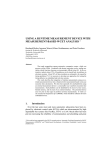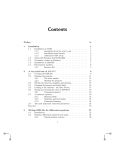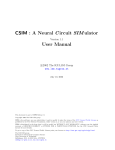Download Network Version 1_40
Transcript
Network 1.40 User Manual Page 1 Network© Version 1.40 User Manual December 26, 2001 Please send all comments and bug reports to Farzan Nadim ([email protected]). 0. Introduction Network is a neuronal network simulation software implemented in C. Network can be used to model single neurons with Hodgkin-Huxley type dynamics, or networks of such neurons connected with synapses. Network supports both a 4th order Runge-Kutta and a variable-time-step integration method. The current version of Network runs in UNIX and the parser is written in bash shell script and gawk. Network is run from the command line and outputs to standard output. There is no graphical interface. At the command line, network reads the name of the project (e.g. project) and looks in the current directory for a configuration file (project.cfg) and a file containing the equations and parameters (project.par). In this text, the command line commands ($ denotes the command prompt) $ command and the contents of files are displayed using the Courier font. 1. Running network The network command line is of the form bash$ network [OPTIONS] project The first argument on the command line is the (user-assigned) name of the project. Assignments of the cell, synapse or network configurations are done in the file project.cfg. Assignments of the equations and parameters are done in the file project.par. The program searches for these 2 files in the current directory and gives an error message if these files are not found. An optional file project.ics can be provided in the current directory for assignment of initial conditions. If this file exists, network automatically reads it. At the end of each simulation run, network produces a file named last that contains the last point of integration. This file can be renamed to project.ics to be used as the initial condition in the next run. If no option is passed to network, by default it will produce the *.c and *.h files and a makefile in the current directory, compiles them and runs the executable. The output is directed to the standard output. The output is currently formatted as a matrix where each row represents one time step. The first element of the row is time and is followed by all the state variables in the order of definition. Network 1.40 User Manual Page 2 Additional options must appear before the project name. The order of the options is irrelevant. The options are passed to network in the standard UNIX format with a hyphen. Whenever the option requires an argument (such as -b begin_time), the space between the 2 parts is required. The current options are: -b begin_time -c generate the *.c and *.h files, compile and produce an executable (called runnetwork) in the current directory and exit without running the executable. -e end_time -h delta_time -k filename keep only variables written in filename. -keep same as –k. -notabulate run without tables (default). -nt same as -notabulate. -par filename use this option to pass additional parameters to network. This option is useful when changing parameters of the model without compiling. Since this file filename is always read after project.par, it is a good way to modify parameters without touching the original project.par file. -r run the executable (runnetwork) in the current directory without compiling the functions. Note that using the options –c and –r together is superfluous since the latter option overrides the former. To compile and run use neither of the two options. -rm remove the *.c and *.h files from the current directory after producing the executable file. -s skip only the first point of this many steps is printed to standard output. Use this option when you have a small delta_time to keep the output small. -t run with tables. This option makes look-up tables for all the steady-state activation and inactivation and time constant functions. The tables are from −150 to 150 mV in increments of 1 mV. Values in between are obtained by linear interpolation. Values outside the range are set to the boundary values. -tabulate same as -t. -v version. -version same as -v. All options may be included in the file $HOME/.network_options and/or project.opt (in the project directory). These files are read in order and latter assignments override the former ones. Command line assignments are read last and override those in the option files. The options that may be included in the option files are the following in Table 1. These options should be included in the file as option=value with no space in between. The # sign at the beginning of the line comments out that option. Network 1.40 User Manual Page 3 The Configuration File The contents of the file project.cfg are necessary for determining the structure of the model. The configuration file is a list of statements, one per line, that describe the structures of the cells or compartments, their connections and the names and types of intrinsic and synaptic currents, without specifying any parameters. Empty lines and anything following a # symbol on each line is ignored. Additional spaces and tabs are also ignored. The program is case sensitive. Table 1. Options in the option files Option REMOVEFILES Command Line Equivalent -rm Default Value Other Values Descritpion 0 1 remove non-executables ERRORFILE - /dev/null filename less serious errors errorfile - /dev/stderr filename more serious errors outputfile - /dev/stdout filename output parse -parse 1 0 parse or not run -r 1 0 run or not compile -c 1 0 compile or not tabulate -t 0 1 tabulate inf and taus (speeds up integration) t0 -b 0 any number begin time tmax -e 100 any number > t0 end time dt -h 0.1 any number integration dt skip -s 10 any positive integer print one point every “skip” 0 1 pipe output through “dd bs=10000” to speed up write to disk “” filename additional parameter file - -1 any number >0 -keep “” filename dd par2 tolerance varfileoption -par tolerance > 0 forces the program to use a variable time step integrator for stiff equations. Otherwise RK4 is used. filename contains variables to be kept. The statement compartment name declares a compartment called name. The terms compartment and cell are equivalent. Such a line also indicates that the lines immediately following will define the contents of this compartment. The statements immediately following are usually definitions of intrinsic ionic currents (see Table 2 for a list): Passive L Network 1.40 User Manual Page 4 mhTauInf Na mTauInf Kd These 3 lines define 3 ionic currents (in the last defined compartment). The first entry on each line defines the type of current and the second entry is the user-assigned name. Table 2. Available types of intrinsic ionic current Type of intrinsic current Properties Passive leak current mTauInf single-gated (activation) current mInst single-gated (activation) instantaneous current mhTauInf double-gated (activation/inactivation) current double-gated (activation/inactivation) current with instantaneous activation mInst_hTauInf The statement synapse comp1 comp2 declares a synaptic connection from the compartment (cell) comp1 to the compartment (cell) comp2. This statement is only meaningful when it is immediately followed by a new line containing the definition of the synapse. For example: GradedmTauInf S defines a graded synapse named S. See Table 3 for available types of synapses. The statement connect comp1 comp2 connects the compartment comp1 to the compartment comp2 symmetrically. Table 3. Available types of synaptic current Type of synaptic current GradedmTauInf GradedmInst GapJunction GradedmTauInf_mpostTauInf GradedmInst_mpostInst AlphaFunction PulseStim I Properties graded (single-gated) synapse graded (single-gated) instantaneous synapse gap-junctional (electrical) synapse (NOT SYMMETRIC) graded (single-gated) synapse with single-gated (activation) dependence on the postsynaptic potential graded (single-gated) instantaneous synapse with single-gated (activation) instantaneous dependence on the postsynaptic potential spike-mediated alpha function αt e1-αt does not define a true synapse, but allows a set of square pulse currents of a fixed amplitude, duration and frequency to be injected into the postsynaptic cell Network 1.40 User Manual ControlledPulse Page 5 does not define a true synapse, but allows a set of square pulse currents of a fixed amplitude, duration and frequency to be injected into the postsynaptic cell, depending on whether the presynaptic cell is above or below some fixed threshold The Parameter File This section describes the contents of the file project.par. These contents depend on the cells and currents defined in the configuration file. The values in the tables are just given as examples. Empty lines and anything following a # symbol on each line is ignored. Additional spaces and tabs are also ignored. The program is case sensitive. The units are arbitrary and the user should be careful to balance the units. Parameter definitions for intrinsic currents are given in the following Table 4. (x, X, v and V are equivalent.) Table 4. Intrinsic parameters that should be defined If this is in project.cfg file These should be in project.par file cell Name or compartment Name Name_Iext=0.0 # pA Name_Cm=100.0 # pF Name_Ga=100.0 # nS (If more than 1 compartment) Name_L_Gmax=10.0 # nS Name_L_Erev=-60.0 # mV Name_Na1_Gmax=100.0 # nS Name_Na1_Erev=50.0 # mV Name_Na1_mpower=3 # must be an integer Name_Na1_minf=1/(1+exp(-(x+45)/2)) Name_Na2_Gmax=120.0 # nS Name_Na2_Erev=50.0 # mV Name_Na2_mpower=3 # must be an integer Name_Na2_minf=1/(1+exp(-(x+55)/3)) Name_Na2_mtau=1+10/(1+exp(-(x+55)/3)) Name_K1_Gmax=120.0 # nS Name_K1_Erev=-80.0 # mV Name_K1_mpower=4 # must be an integer Name_K1_minf=1/(1+exp(-(x+51)/12)) Name_K1_hpower=1 # must be an integer Name_K1_hinf=1/(1+exp((x+50)/3)) Name_K1_htau=10+100/(1+exp((x+52)/3)) Name_Ca_Gmax=11.0 # nS Name_Ca_Erev=-80.0 # mV Name_Ca_mpower=2 # must be an integer Name_Ca_minf=1/(1+exp(-(x+47)/2)) Name_Ca_mtau=10+12/(1+exp((x+52)/3)) Passive L mInst Na1 mTauInf Na2 mInst_hTauInf K1 mhTauInf Ca Network 1.40 User Manual mAlphaBeta K mhAlphaBeta Na Page 6 Name_Ca_hpower=1 # must be an integer Name_Ca_hinf=1/(1+exp((x+50)/3)) Name_Ca_htau=100+200/(1+exp((x+52)/3)) Name_K_Gmax=120.0 # nS Name_K_Erev=-80.0 # mV Name_K_mpower=4 # must be an integer Name_K_malpha=-0.01*(v+55)/(exp(-(v+55)/10)-1) Name_K_mbeta=0.125*exp(-(v+65)/80) Name_Na_Gmax=36.0 # nS Name_Na_Erev=50.0 # mV Name_Na_mpower=4 # must be an integer Name_Na_malpha=-0.01*(v+55)/(exp((v+55)/10)-1) Name_Na_mbeta=0.125*exp(-(v+65)/80) Name_Na_hpower=1 # must be an integer Name_Na_halpha=0.07*exp(-(v+67)/100) Name_Na_hbeta=1/(exp(-(v+37)/10)+1) Parameter definitions for synaptic currents are given in the Table 5. (x, X, v and V are equivalent.) Table 5. Synaptic parameters that should be defined If this is in project.cfg file These should be in project.par file synapse Pre Post # Nothing is necessary yet. Pre_Post_S1_Gmax=10.0 # nS Pre_Post_S1_Erev=-80.0 # mV Pre_Post_S1_minf=1/(1+exp(-(x+55)/3)) Pre_Post_S2_Gmax=10.0 # nS Pre_Post_S2_Erev=-80.0 # mV Pre_Post_S2_minf=1/(1+exp(-(x+55)/3)) Pre_Post_S2_mtau=10+20/(1+exp(-(x+55)/3)) Pre_Post_Elec_Gmax=10.0 # nS Pre_Post_S3_Gmax=10.0 # nS Pre_Post_S3_Erev=-80.0 # mV Pre_Post_S3_minf=1/(1+exp(-(x+55)/3)) Pre_Post_S3_mPosttinf=1/(1+exp(-(x+25)/12)) Pre_Post_S4_Gmax=10.0 # nS Pre_Post_S4_Erev=-80.0 # mV Pre_Post_S4_minf=1/(1+exp(-(x+55)/3)) Pre_Post_S4_mtau=10+20/(1+exp(-(x+55)/3)) Pre_Post_S4_mPosttinf=1/(1+exp(-(x+25)/12)) Pre_Post_S4_mPostttau=200/(1+exp((x+12)/2)) Pre_Post_A_Gmax=10.0 # nS Pre_Post_A_Erev=-80.0 # mV Pre_Post_A_AlphaTau=25 # ms Pre_Post_A_Threshold=-20 # mV: presyn # threshold Pre_Post_A_Slope=1 # 1 or –1: going through # threshold up or down GradedmInst S1 GradedmTauInf S2 GapJunction Elec GradedmInst_mpostInst S3 GradedmTauInf_mpostTauInf S4 AlphaFunction A Network 1.40 User Manual PulseStim I # defined only with # presyn cell NULL ControlledPulse I Page 7 Pre_Post_A_Tolerance=1e-3 # defined by # default to be 1e-3. This decides the time # tolerance to within which 2 events # coincide. NULL_Post_A_Period=1000 # ms defined only # if the presynaptic cell is NULL. # Determines the period of the synapse. NULL_Post_A_Period=50 # ms NULL_Post_A_Duration=2 # ms NULL_Post_A_Amplitude=1000 # pA Pre_Post_I_Period=100.0 # ms Pre_Post_I_Duration=-80.0 # mV Pre_Post_I_Amplitude=1000 # pA Pre_Post_I_Threshold=-20 # mV Pre_Post_I_Delay=10.0 # ms: delay after # threshold crossing & before injection Pre_Post_I_Above=1 # 1 or 0: inject above # threshold or below The Initial Condition File The initial conditions are read from the file project.ics if this file exists in the project directory. The project.ics file should contain each variable on a separate line and each line should be of the form variable=<value> or variable <value> Each time network is run, it creates a file called last that contains the last point of integration. This file could be renamed to project.ics and used as initial conditions for the next run. The UNIX Interface Network is run from the UNIX command line by typing $ network project > outputfile All files associated with network are included in $NETWORKHOME. This directory should be included in the user path or, alternatively, there should be links to the executable files in /usr/local/bin or /usr/bin. Networks involves 3 executable commands: network is the main script, parse_network is the parser and tabulate_network builds the lookup tables for the –t option. Network 1.40 User Manual Page 8 2. Advanced Features The variables file option If keeping all the variables Keeping the current and conductance To keep the values of current (cell_ion_I) and conductance (cell_ion_G), the word keep should appear immediately after the name of the ion in the configuration file. For example if project.cfg contains cell Pyramidal mhTauInf Na keep the output of network project will contain two columns for Pyramidal_Na_G and Pyramidal_Na_I. The calcium-dependent current Network 1.40 User Manual Page 9 3. Tutorials Tutorial #1: A passive cell Make a file called passive.cfg containing the following: cell P Passive L Make a file called passive.par containing the following: P_Iext=0 # pA P_Cm=200 # pF P_L_Gmax=10 # nS P_L_Erev=-60 # mV Make a file called passive.ics containing the following: P_Vm=-60 At the command line type: $ network passive > out The program will inform you that it is parsing, compiling and running. The file out should contain 1000 lines. On each line there should be 2 entries, the first is time and the second is –60. Now create a new file called par2 (this name is arbitrary) that contains P_Iext=1000 # pA At the command line type: $ cp last passive.ics $ network –r –b 100 –e 300 –par par2 passive >> out $ cp last passive.ics $ network –r –b 300 –e 500 passive >> out You just injected a 1 nA pulse of duration 200 ms into the cell. The result is in the file out and can be plotted with gnuplot. Tutorial #2: The Morris-Lecar cell Tutorial #3: The Hodgkin-Huxley cell Tutorial #4: A Passive Cable Tutorial #5: An Active Cable Tutorial #6: Reciprocal Inhibition






















